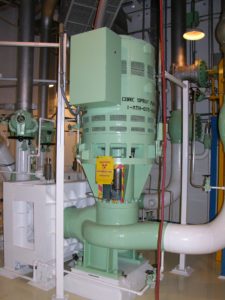On December 21, 1985, the Unit 1 reactor at the Hatch nuclear plant south of Vidalia, Georgia was shut down for a refueling outage. Workers performed a test simulating the loss of the electrical grid for the plant. As designed, the unit’s emergency diesel generators automatically started and supplied power to essential equipment.
A closed maintenance valve on the residual heat removal (RHR) pump suction piping opened when it lost electrical power. This valve contained a spring that pushed the valve open unless compressed air was supplied that overcame the spring force to close the valve. The air compressors supplying air flow to the valve were not powered from the emergency diesel generators, so they stopped functioning when the normal power was turned off.
The normal supply of water to the RHR pumps comes from the torus, a large metal cylinder inside the reactor building holding nearly two million gallons. Water from the torus flowed through the open valve through a disassembled RHR pump suction valve into the pump room. The pump room quickly flooded to a depth of 14 feet. Key equipment in the room, including both RHR pumps and one core spray pump were disabled when they became submerged.
Our Takeaway
Nuclear power plants are very complex. The technology can be intimidating. But a relatively simple concept involves keeping water on the inside of the pumps and piping, not on the outside. Don’t run with scissors. Don’t spit into the wind. Don’t go swimming for at least a half hour after eating. And don’t keep water on the outside of pumps and piping.
“Fission Stories” is a weekly feature by Dave Lochbaum. For more information on nuclear power safety, see the nuclear safety section of UCS’s website and our interactive map, the Nuclear Power Information Tracker.

